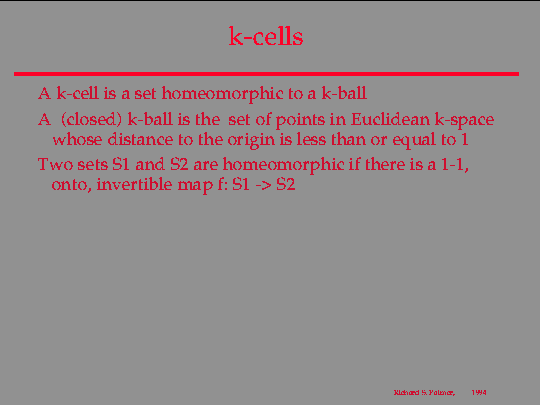
Intuitively, a k-cell is a simple abstract object of dimension k, without any holes. For instance, a point is a 0-cell, a line segment is a 1-cell, a triangle is a 2-cell, and a cube and a tetrahedron are both examples of 3-cells. The concept of a k-cell does not include the notion of shape, in the sense that the notion of a k-cell describes, in a sense all simple k-dimensional objects -- this is what distinguishes topology from geometry. Thus, a line segment and the set f(x) = x*x, for 0<= x <= 10, are both 1-cellsCells can be viewed as being embedded in space, or simply abstract algebraic objects. To define the notion of a cell formally, we start with a set of canonical k-cells, and define all other k-cells in terms of their relationship to these. The canonical k-cells are the k-balls, described above as the subset of Euclidean k-space continuing points at most distance 1 from the origin. A k-cell c is the defined to be any set for which there is a map f:c -> Bk that is 1-1, onto, and invertible. Such a map is called a homeomorphism, and a k-cell is thus any set that is homeomorphic to a k-ball. Thus, homeomorphism defines the notion of topological equivalence. In many cases we are not actually interested in any particular homeomorphism, but only in the fact that one exists. In practical terms, we are interested in cells because we will use them to partition a complex system into a number of simpler pieces. We will use cells to represent these simpler pieces. We will then define constraints that ensure that the systems we build out of these pieces have the desired characteristics. But before we consider how to combine cells to get a complex system, let us look at some examples of cells themselves.